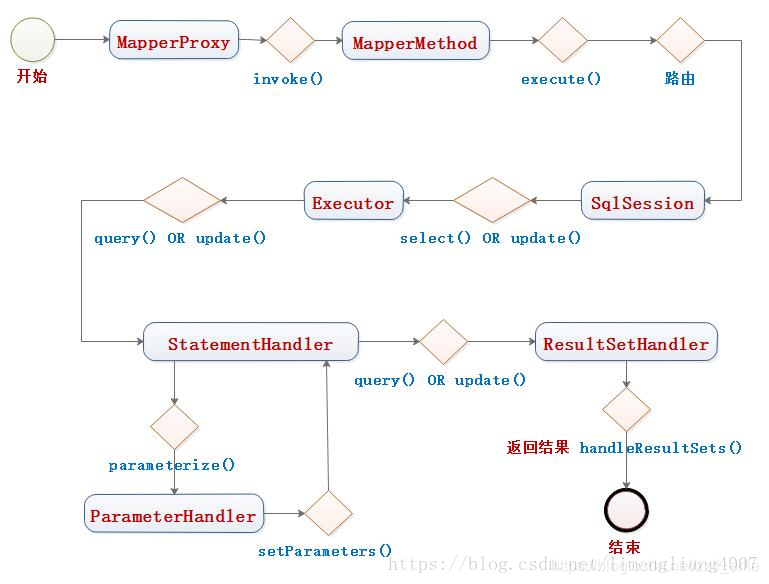GitHub地址
源码解析地址
https://github.com/erlieStar/mybatis-3
debug源码用项目
https://github.com/erlieStar/mybatis-examples
关于Mybatis的动态代理阶段,主要涉及到4个组件
- Executor:一级缓存和二级缓存的实现都在Executor中
- StatementHandler:使用JDBC提供的Statement或PrepareStatement执行操作,起承上启下的作用
- ParameterHandler:对预编译的SQL进行参数设置
- ResultSetHandler:对数据库返回的结果集(ResultSet)进行封装,返回用户指定的实体类型
这个动态代理阶段执行的流程都包含在这张图中,依次追一下代码就能搞定

返回动态代理对象
用上一节的例子来debug动态代理的过程,一步一步追
sqlSession = sqlSessionFactory.openSession(true);
BookMapper bookMapper = sqlSession.getMapper(BookMapper.class);
int num = bookMapper.deleteById(1);
上一篇文章说到sqlSessionFactory的实现类是DefaultSqlSessionFactory,所以openSession返回的是DefaultSqlSession,追getMapper方法
追到了MapperRegistry类,这个类不是在初始化的时候保存了mapper接口对象和相应的MapperProxyFactory的映射关系吗?
private final Map<Class<?>, MapperProxyFactory<?>> knownMappers = new HashMap<Class<?>, MapperProxyFactory<?>>();
答对了,看来要从这放回mapper接口的代理对象了
public <T> T getMapper(Class<T> type, SqlSession sqlSession) {
final MapperProxyFactory<T> mapperProxyFactory = (MapperProxyFactory<T>) knownMappers.get(type);
if (mapperProxyFactory == null) {
throw new BindingException("Type " + type + " is not known to the MapperRegistry.");
}
try {
return mapperProxyFactory.newInstance(sqlSession);
} catch (Exception e) {
throw new BindingException("Error getting mapper instance. Cause: " + e, e);
}
}
发现生成代理的工作都交给MapperProxyFactory类了,没事,接着追
public T newInstance(SqlSession sqlSession) {
final MapperProxy<T> mapperProxy = new MapperProxy<T>(sqlSession, mapperInterface, methodCache);
return newInstance(mapperProxy);
}
protected T newInstance(MapperProxy<T> mapperProxy) {
// 实现了mapper接口的动态代理对象
return (T) Proxy.newProxyInstance(mapperInterface.getClassLoader(), new Class[] { mapperInterface }, mapperProxy);
}
到这终于追完了,对Proxy.newProxyInstance这个动态代理函数不了解的看如下文章
看Proxy.newProxyInstance()方法中的最后一个参数是啥?MapperProxy,原来mapper接口的代理类就是MapperProxy啊。
执行动态代理方法
当执行如下操作的时候,会跳进MapperProxy类的invoke()函数
int num = bookMapper.deleteById(1);
@Override
public Object invoke(Object proxy, Method method, Object[] args) throws Throwable {
// 代理以后,所有Mapper方法调用时,都会执行这个invoke方法
try {
// 如果是Object本身的方法不增强
if (Object.class.equals(method.getDeclaringClass())) {
return method.invoke(this, args);
} else if (isDefaultMethod(method)) {
// 针对java7以上版本对动态类型语言的支持,暂不分析
return invokeDefaultMethod(proxy, method, args);
}
} catch (Throwable t) {
throw ExceptionUtil.unwrapThrowable(t);
}
// 从缓存中获取mapperMethod对象,如果缓存中没有,则创建一个,并添加到缓存中
final MapperMethod mapperMethod = cachedMapperMethod(method);
return mapperMethod.execute(sqlSession, args);
}
执行操作给了MapperMethod类,继续追
public Object execute(SqlSession sqlSession, Object[] args) {
Object result;
switch (command.getType()) {
case INSERT: {
Object param = method.convertArgsToSqlCommandParam(args);
result = rowCountResult(sqlSession.insert(command.getName(), param));
break;
}
case UPDATE: {
Object param = method.convertArgsToSqlCommandParam(args);
result = rowCountResult(sqlSession.update(command.getName(), param));
break;
}
case DELETE: {
Object param = method.convertArgsToSqlCommandParam(args);
result = rowCountResult(sqlSession.delete(command.getName(), param));
break;
}
case SELECT:
if (method.returnsVoid() && method.hasResultHandler()) {
executeWithResultHandler(sqlSession, args);
result = null;
} else if (method.returnsMany()) {
result = executeForMany(sqlSession, args);
} else if (method.returnsMap()) {
result = executeForMap(sqlSession, args);
} else if (method.returnsCursor()) {
result = executeForCursor(sqlSession, args);
} else {
// 处理返回为单一对象的情况
// 通过参数解析器解析参数
Object param = method.convertArgsToSqlCommandParam(args);
result = sqlSession.selectOne(command.getName(), param);
}
break;
case FLUSH:
result = sqlSession.flushStatements();
break;
default:
throw new BindingException("Unknown execution method for: " + command.getName());
}
if (result == null && method.getReturnType().isPrimitive() && !method.returnsVoid()) {
throw new BindingException("Mapper method '" + command.getName()
+ " attempted to return null from a method with a primitive return type (" + method.getReturnType() + ").");
}
return result;
}
根据sql语句的不同类型,将执行权交给了Sqlsession
DefaultSqlSession交给Executor(执行器)
@Override
public int update(String statement, Object parameter) {
try {
dirty = true;
// statement为命名空间+方法名
MappedStatement ms = configuration.getMappedStatement(statement);
return executor.update(ms, wrapCollection(parameter));
} catch (Exception e) {
throw ExceptionFactory.wrapException("Error updating database. Cause: " + e, e);
} finally {
ErrorContext.instance().reset();
}
}
接着调用会依次经过CachingExecutor和SimpleExecutor
因为我们发现DefaultSqlSession传入的Executor通过如下方法返回的
public Executor newExecutor(Transaction transaction, ExecutorType executorType) {
executorType = executorType == null ? defaultExecutorType : executorType;
// 防止粗心大意的人将defaultExecutorType设为null
executorType = executorType == null ? ExecutorType.SIMPLE : executorType;
Executor executor;
if (ExecutorType.BATCH == executorType) {
executor = new BatchExecutor(this, transaction);
} else if (ExecutorType.REUSE == executorType) {
executor = new ReuseExecutor(this, transaction);
} else {
executor = new SimpleExecutor(this, transaction);
}
// 开启二级缓存,用装饰器模式装饰一下
if (cacheEnabled) {
executor = new CachingExecutor(executor);
}
// 创建代理对象,插件在这里起作用
executor = (Executor) interceptorChain.pluginAll(executor);
return executor;
}
方法传入的executorType为defaultExecutorType
protected ExecutorType defaultExecutorType = ExecutorType.SIMPLE;
而cacheEnabled(控制二级缓存)默认值为true,所用会用CachingExecutor装饰SimpleExecutor
接着进入SimpleExecutor的doUpate方法
@Override
public int doUpdate(MappedStatement ms, Object parameter) throws SQLException {
Statement stmt = null;
try {
Configuration configuration = ms.getConfiguration();
StatementHandler handler = configuration.newStatementHandler(this, ms, parameter, RowBounds.DEFAULT, null, null);
stmt = prepareStatement(handler, ms.getStatementLog());
return handler.update(stmt);
} finally {
closeStatement(stmt);
}
}
创建了一个PreparedStatementHandler,因为从MappedStatement类中可以看到statementType类型为PREPARED
mappedStatement.statementType = StatementType.PREPARED;
并且从PreparedStatementHandler得到一个PreparedStatement
handler.parameterize(stmt);
接着PreparedStatementHandler使用ParameterHandler设置SQL中的参数
到了SimpleStatementHandler的update方法
@Override
public int update(Statement statement) throws SQLException {
String sql = boundSql.getSql();
Object parameterObject = boundSql.getParameterObject();
KeyGenerator keyGenerator = mappedStatement.getKeyGenerator();
int rows;
if (keyGenerator instanceof Jdbc3KeyGenerator) {
statement.execute(sql, Statement.RETURN_GENERATED_KEYS);
rows = statement.getUpdateCount();
keyGenerator.processAfter(executor, mappedStatement, statement, parameterObject);
} else if (keyGenerator instanceof SelectKeyGenerator) {
statement.execute(sql);
rows = statement.getUpdateCount();
keyGenerator.processAfter(executor, mappedStatement, statement, parameterObject);
} else {
statement.execute(sql);
rows = statement.getUpdateCount();
}
return rows;
}
终于看到JDBC的原生写法
statement.execute()
至此,删除流程完毕
整个执行的流程图如下
Executor详解
SimpleExecutor:默认配置,使用PreparedStatement对象访问数据库,每次访问都要创建新的PreparedStatement对象
ReuseExecutor:使用PreparedStatement对象访问数据库,访问时会重用statement对象
BatchExecutor:实现执行多条SQL语句的能力
总结
调用链路如下
MapperProxy:拦截Mapper方法
MapperMethod:根据语句的不同类型调用DefaultSqlSession
DefaultSqlSession:将执行权交给Executor
Executor:生成StatementHandler
ParameterHandler:将生成的StatementHandler中的SQL进行预编译
ResultSetHandler:对数据库返回的结果集(ResultSet)进行封装,返回用户指定的实体类型
参考博客
[1]https://www.jianshu.com/p/46c6e56d9774
